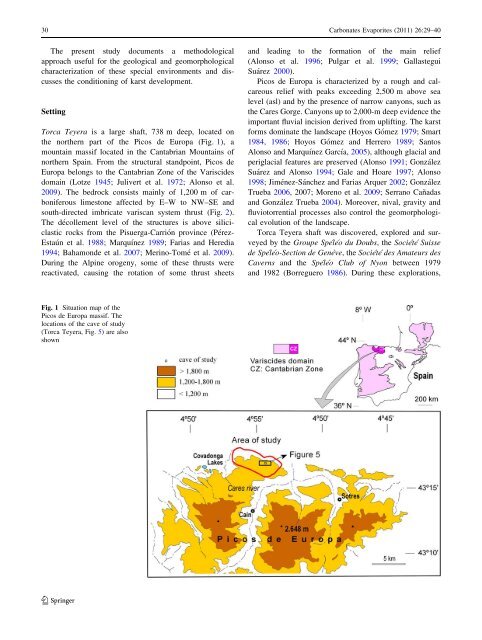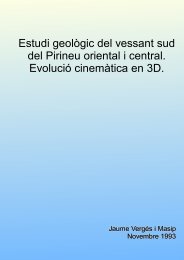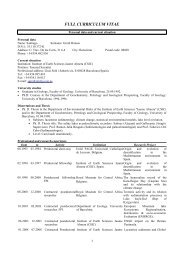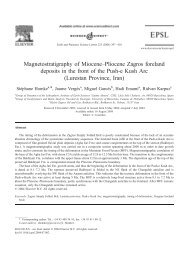1.3 MB - Instituto de Ciencias de la Tierra Jaume Almera
1.3 MB - Instituto de Ciencias de la Tierra Jaume Almera
1.3 MB - Instituto de Ciencias de la Tierra Jaume Almera
You also want an ePaper? Increase the reach of your titles
YUMPU automatically turns print PDFs into web optimized ePapers that Google loves.
30 Carbonates Evaporites (2011) 26:29–40<br />
The present study documents a methodological<br />
approach useful for the geological and geomorphological<br />
characterization of these special environments and discusses<br />
the conditioning of karst <strong>de</strong>velopment.<br />
Setting<br />
Torca Teyera is a <strong>la</strong>rge shaft, 738 m <strong>de</strong>ep, located on<br />
the northern part of the Picos <strong>de</strong> Europa (Fig. 1), a<br />
mountain massif located in the Cantabrian Mountains of<br />
northern Spain. From the structural standpoint, Picos <strong>de</strong><br />
Europa belongs to the Cantabrian Zone of the Varisci<strong>de</strong>s<br />
domain (Lotze 1945; Julivert et al. 1972; Alonso et al.<br />
2009). The bedrock consists mainly of 1,200 m of carboniferous<br />
limestone affected by E–W to NW–SE and<br />
south-directed imbricate variscan system thrust (Fig. 2).<br />
The décollement level of the structures is above silicic<strong>la</strong>stic<br />
rocks from the Pisuerga-Carrión province (Pérez-<br />
Estaún et al. 1988; Marquínez 1989; Farias and Heredia<br />
1994; Bahamon<strong>de</strong> et al. 2007; Merino-Tomé et al. 2009).<br />
During the Alpine orogeny, some of these thrusts were<br />
reactivated, causing the rotation of some thrust sheets<br />
Fig. 1 Situation map of the<br />
Picos <strong>de</strong> Europa massif. The<br />
locations of the cave of study<br />
(Torca Teyera, Fig. 5) are also<br />
shown<br />
123<br />
and leading to the formation of the main relief<br />
(Alonso et al. 1996; Pulgar et al. 1999; Gal<strong>la</strong>stegui<br />
Suárez 2000).<br />
Picos <strong>de</strong> Europa is characterized by a rough and calcareous<br />
relief with peaks exceeding 2,500 m above sea<br />
level (asl) and by the presence of narrow canyons, such as<br />
the Cares Gorge. Canyons up to 2,000-m <strong>de</strong>ep evi<strong>de</strong>nce the<br />
important fluvial incision <strong>de</strong>rived from uplifting. The karst<br />
forms dominate the <strong>la</strong>ndscape (Hoyos Gómez 1979; Smart<br />
1984, 1986; Hoyos Gómez and Herrero 1989; Santos<br />
Alonso and Marquínez García, 2005), although g<strong>la</strong>cial and<br />
perig<strong>la</strong>cial features are preserved (Alonso 1991; González<br />
Suárez and Alonso 1994; Gale and Hoare 1997; Alonso<br />
1998; Jiménez-Sánchez and Farias Arquer 2002; González<br />
Trueba 2006, 2007; Moreno et al. 2009; Serrano Cañadas<br />
and González Trueba 2004). Moreover, nival, gravity and<br />
fluviotorrential processes also control the geomorphological<br />
evolution of the <strong>la</strong>ndscape.<br />
Torca Teyera shaft was discovered, explored and surveyed<br />
by the Groupe Spéléo du Doubs, the Société Suisse<br />
<strong>de</strong> Spéléo-Section <strong>de</strong> Genève, the Société <strong>de</strong>s Amateurs <strong>de</strong>s<br />
Caverns and the Spéléo Club of Nyon between 1979<br />
and 1982 (Borreguero 1986). During these explorations,





